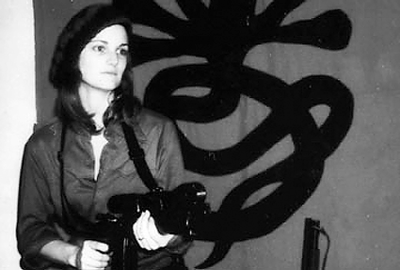Filmmaker documents the Patty Hearst kidnapping that rocked America in the early 1970s
Many of us remember it as a collective nightmare. The year was 1974. After many long years of fighting, peace between the United States and Vietnam had finally been declared. Richard Nixon’s re-election crimes had degenerated into what came to be known as Watergate. Trouble brewed in the Middle East, and the U.S. had an energy crisis on its hands.
Then, one night on the evening news, there was Walter Cronkite, reporting that 19-year-old “newspaper heiress” Patty Hearst, granddaughter of the publishing baron, William Randolph Hearst, had been kidnapped. Armed men had broken into the apartment on a quiet Berkeley street that Hearst shared with her fiancé. The Hearst family, including her father who owned the San Francisco Examiner, was devastated and the nation was riveted. A media maelstrom of unprecedented intensity ensued.
The new documentary from filmmaker Robert Stone, “Guerilla: The Taking of Patty Hearst,” opens with a scratchy voice-over and a close-up shot of a Nagra tape player. In a menacing tone, a man calling himself “General Field Marshal Cinque,” the nom de guerre of Donald DeFreeze, introduces to America the Symbionese Liberation Army, a guerilla group whose stated goal was to overthrow the government. Then, the tentative first words from the kidnapped victim to her family and the rest of the world: “Mom, Dad, I’m with a combat unit that’s armed with automatic weapons.”
Music pounds, titles roll, and the camera slowly zooms in on a photograph of Hearst. The first moments of Stone’s film set up a sense of mystery and dread as he introduces the drama as it unfolded three decades ago.
Political and social unrest roiled the nation in the late 1960s and early 70s. Progressives and radicals challenged a social order long dominated by a heterosexual white patriarchy, with emerging feminist, gay and African-American claims to equality. Vietnam War protests flared across the nation, particularly following the killing of four students at Kent State University by Ohio National Guard troops. A radical series of movements were spawned, often with inchoate objectives, but typically seeking to address longstanding economic injustices and, in their neo-Marxist embodiments, re-ordering class hierarchies.
Television captured all of it, from American G.I.’s shooting Vietcong insurgents in the jungle to vivid images of massive demonstrations, interspersed with the speeches of soon-to-be dead historic figures such as Che Guevera and the Rev. Martin Luther King, Jr.
Widespread rage about government corruption coalesced in the California Prison Movement, in which leftist students denounced the widespread incarceration of African Americans as a political and social weapon whose legacy was rooted in the nation’s slave era. Willie Wolf, Russ Little, Emily and Bill Harris, Joe Remiro and Nancy Ling Perry, six such radicals, visited prisons, demanding an overthrow of the criminal justice system.
After inmate Donald DeFreeze escaped from prison and sought refuge with his friends Little and Wolf, the Symbionese Liberation Army was born. The group’s motto was “Death to the fascist insect that preys upon the life of the people.” Their first attack, in November, 1973, was the assassination of Marcus Foster, Oakland’s first American-American public schools superintendent. DeFreeze considered Foster to be in collusion with the white establishment. The murder stunned the nation and especially California, where Foster was regarded as a positive role model for young blacks and whites alike.
Two months later, after a shoot-out with police, Little and Remiro were arrested and charged with Foster’s murder. Three weeks later, on February 4, Angela Atwood, Defreeze and Bill Harris broke into Patty Hearst’s apartment, assaulted Steve Wood, her fiancé, and kidnapped the young woman. In a harbinger of today’s nonstop cable news coverage, reporters camped out in front of the Hearst mansion, and waited.
Ultimately, that massive media presence served as the liaison between the family and the SLA. Initially, the SLA sought ransom from the Hearst family, including six million dollars for a massive food giveaway to poor people in California. What began as a potent reminder of poverty in America, erupted as a riot with racial overtones.
Soon afterward, an extraordinary communiqué announced that Patty Hearst had in fact joined the SLA. In a shocking announcement, Hearst declared her intention to fight “for my freedom and the freedom of all oppressed people,” her transformation from society girl to urban guerilla complete including a new moniker, “Tania.” The nation’s obsession with the story became feverish, with news networks battling each other for scraps of exclusive footage.
The story led the news each evening, each painstaking day ticked off in America’s living rooms. Twelve days later Patty Hearst was seen again in a shocking image captured on a bank’s security camera. A machine gun-toting Hearst shouts at customers, cocking her weapon’s muzzle at everyone in sight, as the SLA robs the Hibernia Bank in San Francisco. That silent black-and-white image remains seared into the minds of people who first watched it on the nightly news.
With “Guerilla: The Taking of Patty Hearst,” Robert Stone takes a unique approach to illuminating lesser-known aspects of a well-told story. The film is constructed from three narrative points—that of Russ Little, Mike Bortin, a radical activist who joined the SLA, and the media.
One of the SLA’s founding members, Little was arrested in January, 1974 for the Foster murder, and was eventually acquitted on retrial. He and Joe Remiro remained in prison for the duration of the Hearst kidnapping and for many years afterward. Little has never before spoken publicly about the SLA and his participation in the film was a significant advantage for the filmmaker.
A Pensacola, Florida native, Little grew up wanting to be an astronaut. During his undergraduate years, his opposition to the Vietnam War radicalized him. The Kent State shootings, he says, appalled him “just like everybody else.” After the U.S. pulled out of Vietnam in 1973 during the Nixon administration, nothing had really changed, Little felt, because “the same criminals and murderers” were in charge of the government. Little wound up in California and showed political films that gained him something of a following.
Like Little, Bortin had excelled academically as a student, but his ambition was tempered during the ‘60s when he became “disgusted” by the actions of those in power. Having saved the world from Hitler, Bortin says, the American military was “running rampant around the world and lying like hell about it.”
Without overtly agreeing with the SLA’s philosophy, Stone illustrates the general dissatisfaction and rage with the government at the time, using potent images of American fighter jets firebombing Vietnam to illustrate just how unpopular the war became with the American public.
Eventually, the gang fled from its base in San Francisco to Los Angeles. Bortin describes the SLA movement as “very Bonnie and Clyde.” Stealing the media spotlight was “very American, actually, just these guys were doing it so artistically,” Bortin says. Following their flight from a botched robbery at a sporting goods store, during which Hearst fired a rifle from across the street to cover the fleeing thieves, a number of the guerillas holed up in a house. The following day, May 17, 1974, six members of the SLA perished in a two-hour, televised standoff with more than 400 LAPD officers and FBI agents who surrounded the neighborhood. (At the time, Hearst was in hiding elsewhere. She was apprehended and arrested that September.)
Never before had such an event been broadcast live. This footage is riveting, underscoring clearly how the media became a key player in the ongoing Hearst saga.
In her 1976 trial, Hearst testified against her counterparts, in a defense that popularized the term “Stockholm syndrome,” describing a condition in which captives sympathize with their captors. Nevertheless, Hearst was convicted and sent to jail. Pres. Jimmy Carter commuted her sentence after 22 months, releasing her from prison in 1979.
In 2002, Bortin and several other SLA fugitives pled guilty for a 1975 bank robbery in which a female customer was shot dead. Bortin is serving a six-year sentence.
Stone and his team have created a powerful film with “Guerilla.” As gripping as were these events, the film does not glorify the actions of the Symbionese Liberation Army, nor does it minimize them. The archival footage, much of which is seen for the first time, was carefully selected to allow the viewer to feel that the events are unfolding in real time. The music, sound design and editing create a disquieting, dark mood throughout the film.
The film has some weaknesses. For example, without any of the actual kidnappers’ participation, the film lacks a certain visceral understanding of Patty Hearst’s transformation to Tania and of life on the run for fugitives subjected to such intense media and law enforcement scrutiny.
“Guerilla” manages to recount the awe and horror of the mayhem created by a band of self-described social revolutionaries. Their youthful aspirations were ultimately undermined by their own foolhardy, bloody choices. Conservative politicians deftly scapegoated the group and others like it to support a more forceful and punitive approach to urban crime and political dissent. In some ways, the political left has never stopped paying the price.




































